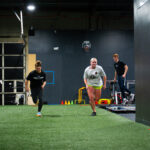Speed Training for Youth Athletes
Speed training is essential for youth athletes. It helps improve performance in sports like soccer, football, basketball, and track. More importantly, it builds coordination, confidence, and injury resistance during critical developmental years.
In this article, we’ll break down how to structure safe and effective speed training for young athletes.
Why Start Speed Training Early?
Introducing speed training early builds athletic foundations. Children and teens experience rapid neuromuscular growth, making this a perfect time to develop movement skills.
When done correctly, youth speed training improves:
-
Sprinting form
-
Quickness and agility
-
Balance and coordination
-
Overall athletic ability
Plus, it helps reduce injury risk by teaching proper mechanics and muscle control.
Key Principles of Speed Training for Youth
Youth speed training isn’t just scaled-down adult training. It requires a different approach focused on development, not intensity.
1. Prioritize Technique Over Speed
Children must learn the correct way to run before trying to run fast. Drills should emphasize posture, foot placement, arm action, and stride rhythm.
2. Make It Fun
Young athletes respond well to engaging, game-like drills. Keep sessions playful to build enthusiasm and consistency.
3. Use Bodyweight Exercises
There’s no need for heavy weights. Bodyweight drills improve control, mobility, and explosive movement without added strain.
Sample Speed Training Drills for Youth
These simple drills build essential movement patterns and sprinting skills:
Skipping Drills
-
A-skips and B-skips build rhythm and coordination.
-
Perform 2 sets of 20 meters, focusing on smooth motion.
Cone Accelerations
-
Sprint 10 yards from a standing start.
-
Add variety by changing start positions (lying down, sideways, etc.).
Ladder Drills
-
Use an agility ladder to practice quick footwork.
-
Try 3 drills like single steps, icky shuffle, or lateral hops.
Mini-Hurdle Jumps
-
Set up low hurdles for quick bouncing steps.
-
Focus on fast feet and knee drive.
Each drill helps develop control, rhythm, and reaction time.
Weekly Speed Training Plan for Youth Athletes
Here’s a basic weekly layout for athletes aged 8–14:
Day 1: Sprint Technique + Coordination
-
Warm-up
-
A-skips, wall drills, cone sprints
-
Ladder drills
-
Cool down
Day 2: Power + Acceleration
-
Warm-up
-
Bounding, mini-hurdles, hill sprints
-
Relay races or tag games
-
Cool down
Each session should last about 30–45 minutes, 2–3 times per week.
How Coaches and Parents Can Support
Parental and coaching support makes youth speed training more effective.
-
Encourage, don’t pressure. Celebrate effort and progress.
-
Track improvements. Use fun challenges or timing to show growth.
-
Ensure proper rest. Young athletes need recovery just like adults.
-
Offer professional guidance. Programs like Next Level Athletics USA specialize in age-appropriate athlete development.
You can also reference NSCA’s Youth Training Guidelines for expert recommendations.
Mistakes to Avoid in Youth Speed Training
Speed training should never be rushed or forced. Avoid these common mistakes:
-
Skipping technique work: Bad habits are hard to unlearn later.
-
Overtraining: More isn’t always better. Two to three sessions per week are enough.
-
Ignoring warm-ups: Always start with dynamic movement to prepare the body.
-
Focusing only on speed: Combine drills with agility, coordination, and fun games.
Conclusion: Build the Foundation Early
Speed training for youth athletes builds physical ability and mental confidence. With the right structure, kids can develop safely while having fun.
Remember to prioritize form, keep sessions engaging, and support long-term development. By investing in proper speed training now, you’re setting young athletes up for a future of success in any sport.
Ready to take the next step? Find expert-led youth training programs at Next Level Athletics USA and give your child a head start.


Recent Comments